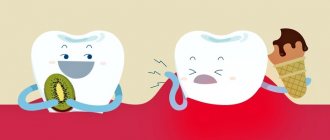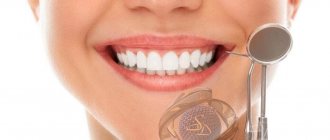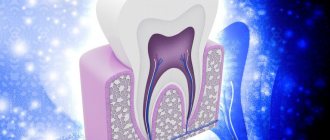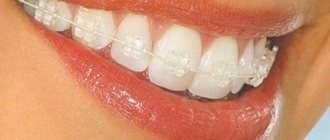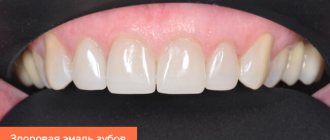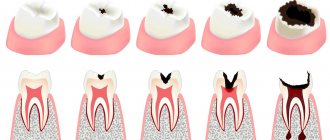Dental demineralization is a widespread problem among both adults and children. It not only worsens the appearance of the dentition, but is also a prerequisite for the development of caries, its initial stage. Demineralization of tooth enamel is a pathological process of loss of mineral components by dental tissue, resulting in dullness, hypersensitivity, fragility of teeth, roughness, porosity of their surface, and often the presence of cracks (photo below). The main sign of pathology is the presence on the surface of the teeth of matte white, slightly grayish, or brownish spots of varying sizes, which are located in most cases in the cervical areas, but can cover the entire crown (photo below). Due to the presence of such spots, the pathology is also called focal demineralization of the enamel.
In this article we will tell you the reasons for focal demineralization of enamel, what it looks like in the photo, what features it differs in children, and we will also introduce you to treatment methods and what needs to be done for this disease.
How does remineralization occur?
Every day our body is exposed to the negative effects of various factors. The process of weakening enamel can be started due to poor nutrition, poor drinking water, regular overexertion and a general lack of organic substances.
When pathogenic flora begins to develop in the oral cavity, the mechanism of natural remineralization of teeth, which works continuously under normal conditions, is disrupted; the leaching of mineral elements begins. The process is called “demineralization,” and if it is not stopped, carious disease and a number of other pathologies can develop.
Remineralization of tooth enamel is the opposite of demineralization. Remineralization can be achieved through restorative procedures that will restore strength to dental tissue and increase its resistance to pathogenic bacteria. There are several recovery options:
- Natural remineralization of teeth: replenishing the balance of biologically significant elements through the consumption of foods high in calcium and fluoride, and additional oral hygiene procedures.
- Artificial remineralization: saturation of enamel using remineralizing drugs. It is carried out both in the dental office and at home.
Is it possible to completely restore enamel on your own?
Contrary to the fact that many want to see a positive answer in this section, there will not be one. If the coating began to deteriorate, then there were contributing factors, which do not always depend on whether the person cracked nuts with his teeth or not. You can only partially slow down this process before you can visit the dentist’s office and take drastic measures.
For protection, doctors offer the thinnest veneers. They are not felt in the mouth, do not bring the slightest discomfort, but at the same time, ceramics prevent microorganisms from reaching the protective shell and penetrating deep into the crown. In addition, the doctor can coat the dental plates with a fluoridating or remineralizing composition, which will prevent destruction for a long time. Therefore, to the question: how and whether it is possible to restore enamel on teeth at all, the answer will only be denial.
Who is the procedure indicated for?
Remineralization and fluoridation of teeth is prescribed for the following problems:
- sensitive reaction of enamel to temperature differences
- pathological abrasion of teeth
- recovery after orthodontic treatment
- impaired metabolism in the body
- mineral deficiency during pregnancy, menopause or puberty
- weakened enamel after professional whitening
Who should not undergo the procedure: people intolerant to remineralizing drugs, as well as those who have kidney disease and problems with the pancreas.
Effect after remotherapy
Remotherapy is an absolutely painless procedure. No anesthesia is required. Remineralization is safe and can be carried out during pregnancy, prescribed to children to strengthen the enamel of baby teeth and as the main means of caries prevention. Remotherapy can reduce tooth sensitivity, improve the structure of the enamel, making it denser, stronger and more resistant to acids and other aggressive substances.
In combination with other methods of prevention, such as fissure sealing, fluoridation and ozone therapy, remotherapy can reduce the risk of developing a carious process to zero. Often, along with dental treatment, gum treatment and diet correction with medications and vitamins are required. In addition, remotherapy is necessarily carried out after teeth whitening and orthodontic treatment procedures. Remotherapy is also necessary for pregnant women and adolescents.
Remineralization of tooth enamel as professional hygiene
Professional remineralization can be carried out using various means:
Fluoride varnish
The teeth are coated with a concentrated fluoride composition, which saturates the hard tissues and helps resist carious bacteria.
Artificial enamel
Also serves to coat teeth to prevent problems with natural enamel. But if the hard tissue has already undergone negative changes, this method will not help get rid of the consequences, so it is advisable to resort to it in order to prevent the disease in the future.
Electrophoresis
One of the most popular and effective methods of deep remineralization of teeth. The procedure consists of electrotherapy with the introduction of remineralizing substances.
Prevention
To prevent demineralization and after remineralization, careful oral hygiene is important: brushing teeth, rinsing with pharmaceutical rinses, using dental floss, a balanced diet, limiting coffee and sweet foods, avoiding smoking. In any case, visiting the dentist 2 times a year is simply necessary.
Despite all the effectiveness of remineralization, this method of tooth restoration is used at the initial stage of demineralization (when white spots appear). If the destruction of tooth enamel has acquired an advanced form, then the patient is unlikely to be able to avoid a drill or prosthetics. Take care of your teeth!
Sources used:
- Prevention of caries in the pits and fissures of teeth / T.V. Popruzhenko. - M.: MEDpress-inform, 2010.
- Prevention of inflammatory periodontal diseases. Textbook / A.I. Abdurakhmanov et al. - M.: GEOTAR-Media, 2015.
- Professional prevention in dental practice / Jean-François Roulet, Stefan Zimmer. - M.: MEDpress-inform, 2010.
- Fejerskov, O., Nyvad, Bente, & Kidd, Edwina A. M. (2015). Dental caries: The disease and its clinical management (Third ed.)
- St. Petersburg State Pediatric Medical University
Remineralization of teeth at home
You can solve the problem of thinning enamel not only in the dental office, but also on your own. For this purpose, there are various lines of drugs for remineralization of teeth. It makes sense to carry out such activities without professional help only if there is no visible damage to the dental tissue.
Important!
It is optimal to remineralize teeth at home with two different pastes with fluoride and calcium. It is recommended to brush your teeth first in the morning, and the second before bed. Make sure that one product does not contain both components, since together they create a stable connection and become useless.
In order for teeth remineralization to bring the best results, you must first brush your teeth thoroughly. This will allow the drug to most effectively contact the surface of the teeth.
One of the popular methods of saturating tooth enamel at home is remineralizing teeth with salt. To do this, it is best to use sea salt powder mixed with a few drops of vegetable oil to form a paste. The resulting mass should be rubbed in in the morning and at the end of the day after the teeth have been brushed.
You can also try gum massage at home. The attending physician will tell you what kind of massage promotes the remineralization of hard dental tissues.
A properly formulated diet will help maintain a healthy balance of minerals. The more you consume foods containing calcium, fluoride and phosphorus, the lower the risk of enamel destruction. These include:
- milk, sour cream, cream, cottage cheese;
- meat products;
- cabbage, spinach, zucchini and other green vegetables;
- almonds and sesame;
- soybeans, beans, chickpeas, peas.
It is recommended to add vitamins and minerals from time to time, but it is better to ask your dentist or therapist about your specific choice.
What causes increased tooth sensitivity?
Tooth enamel is one of the strongest tissues in the body. It consists of 98% microelements. It is believed that if it gets on a tooth, even a product made of Damascus steel can become dull. However, often the strength of dental tissue may not be enough to last a lifetime. Normally, the processes of strengthening enamel (remineralization) and loosening it (demineralization) are balanced. If for some reason the process of leaching of trace elements begins in the body, then they speak of demineralization. At the same time, microelements that ensure its strength are washed out of the bone tissue (calcium, magnesium, potassium, phosphorus, fluorine, potassium, etc.)
Causes of demineralization
Normally, the mineralization of dental tissue is significantly higher than the mineralization of bone tissue. The increased hardness of tooth enamel is associated with its composition, when the calcium compound is protected by the presence of other microelements. Excess or lack of trace elements in the body also causes dental problems. One of the main “guardians” of tooth enamel is fluoride, which protects calcium from dissolution and leaching. However, as fluoride levels increase, tooth enamel also begins to darken and erode (fluorosis).
What needs to happen to the body for tooth enamel to begin to lose its former strength? Typically, tooth decay in the body is provoked by the same reasons that cause the destruction of bone tissue. Often this process is associated with a violation of the supply or absorption of essential minerals in the body, especially calcium and phosphorus. Metabolic failure in the body can occur when absorption is impaired at one of the levels. This may be due to reasons related to:
- excessive consumption of sugars;
- malabsorption in the intestine;
- impaired digestion of food (with celiac disease, dysbacteriosis);
- diseases of the endocrine system associated with metabolic disorders (diseases of the thyroid gland or adrenal glands, diabetes mellitus, etc.);
- lack of enzymatic activity that increases the absorption of minerals.
In addition to general disorders in the body, mineralization disorders can occur when:
- poor dental hygiene;
- dental crowding;
- inflammation of the gums;
- improper use of orthodontic structures.
All of the above diseases and situations contribute to the softening of the enamel and can lead to its complete destruction.
Means for remineralization of teeth
For modern remineralization of teeth at home, there are many effective means that can be used not only for prevention, but also for treatment.
Pastes:
JASON Sea Fresh with fluoride is a gel paste with therapeutic and prophylactic effects. Fluoride and various plant extracts protect against pathogenic bacteria and enrich the enamel.
Biorepair Total Protection Plus is an antibacterial paste, especially suitable for those who have just undergone orthodontic treatment with braces. The product is hypoallergenic. For even more effective remineralization of tooth enamel, you can supplement it with Biorepair Night Repair paste, which restores enamel overnight.
Theodent Classic - unlike other brands of toothpastes, this is the only one that contains the unique patented element theobromine. The properties of theobromine contribute not only to the restoration, but also to the production of enamel. This is the best option for caries prevention.
Twin Lotus SENSITIVITY - a paste recommended for people with increased sensitivity of teeth, as it effectively reduces pain due to aloe and acmella in the composition and strengthens the enamel.
Miradent® Mirasensitive hap+ - reduces sensitivity, while the potassium ions in the composition provide protection right down to the nerve of the tooth.
Gels:
GLOBAL WHITE is a remineralizing gel from a famous American brand. Effectively reduces the sensitivity threshold and restores weakened enamel.
Miradent® gel is an intensive protective agent for the remineralization of teeth with fluoride, recommended for the prevention of caries.
For convenient use of gels, you can purchase special trays for Diamondbrite remineralizing applications.
Mousses and foams:
GC Tooth Mousse is a mousse for the remineralization of hard dental tissues, helps reduce sensitivity, prevent plaque formation and neutralize acidity in the oral cavity. Not suitable for people with allergies to milk proteins.
Professor Persin is a restorative foam for those who do not always have the opportunity to brush their teeth. Helps reduce sensitivity, strengthen enamel and generally have a beneficial effect on oral health.
Rinse aids:
4-action BioRepair is a remineralizing rinse for people with hypersensitive teeth. Thanks to the active Microrepair® particles in the composition, it restores enamel even in the most difficult to reach places, prevents the formation of tartar and the development of caries.
The listed means of teeth remineralization can be used either independently or in addition to professional treatment. You should consult with a specialist regarding the choice of specific products for better remineralization of teeth.
Symptoms of dental mineralization disorders
How can one suspect that a person has begun the process of demineralization?
The earliest manifestation of demineralization is focal damage to the enamel. In this case, white spots become noticeable on the tooth enamel, which are located on the tooth base or at the junction of two teeth. The stains can be barely noticeable or occupy an entire tooth. Initially, the patient has one or two teeth affected. This pathology occurs especially often in children under 11 years of age. It also occurs in adults, but much less frequently.
At the initial stage, when demineralization is just beginning to break down, it is very difficult to detect.
The main manifestations of enamel pathology at an early stage are:
- decreased shine of teeth;
- acquisition of dullness by teeth.
Then the pathological process intensifies and becomes more pronounced, which is manifested by symptoms:
- streaks or chalky spots on the enamel;
- porosity, roughness and deformation of enamel;
- darkening of white spots on the enamel, subsequently turning brown.
Thinning tooth enamel begins to darken and decay, forming carious lesions on the teeth. And this process cannot end on its own. Therefore, even with minimal suspicion of the onset of enamel destruction, it is important to consult a dentist as soon as possible.
